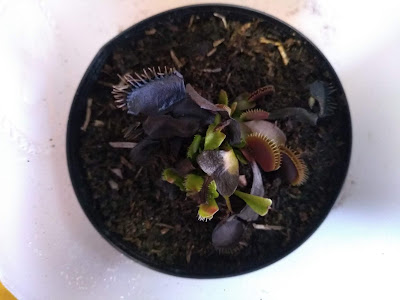I grow a few carnivorous plants from seed. Some are fast from seed, others take a long time. It is important to keep different types separate as they are so small that drops of rain could potentially splash them into each other's pots (don't ask how I know).
Most people have never grown carnivorous plants from seed, and have no idea what to expect, so I thought I would show some of mine.
Drosera capillaris
I had some unknown sundew seeds hitch hike in with a venus flytrap I bought through the post. They eventually germinated, started to grow, and appear to be Drosera capillaris. I plan to grow them to maturity, identify them properly, and hopefully collect seed to grow some more.
If
you look closely at the tiny plant at the top left you will see it
caught a mosquito that is over half the size as the plant! I don't
understand why, but my drosera always seem to catch a lot of
mosquitoes.
I have grown capillaris before, they are small plants that are simple to grow and I think they look nice. If all goes well they should flower before winter.
 |
| Drosera capillaris - caught a mosquito at this tiny size |
Drosera burmanii
I bought some seeds of Drosera burmanii. This is a small rosette sundew that usually only lives for a year. They are meant to drop a lot of seed over their short lives and be simple to grow. I usually grow perennial sundews, so this tiny annual is something a bit different.
Drosera burmanii have snap tentacles, and are the second fastest moving tentacles of all Drosera species. I can hardly wait to see what they are like when they reach maturity. At this tiny size they are catching springtails.
 |
| Drosera burmanii - tiny seedlings |
Sarracenia
A very generous person sent me three types of Sarracenia seed. I cold wet stratified them, planted them, and they have started to germinate.
Sarracenia cotyledons are like any other plant, they are not carnivorous at this stage. The first true leaves on the other hand are carnivorous. The photo isn't great, but if you look closely you can see the first true leaves are tiny carnivorous pitchers. I can't imagine any insect gets caught by the first carnivorous leaves, but the second set of carnivorous leaves should be large enough to catch tiny ants and gnats.
Unfortunately they got hit pretty badly by a recent storm and many of my seedlings were washed away. I still have the largest seedlings and there are plenty more seeds in my fridge. It takes a few good years before these plants will grow to a decent size.
 |
| Sarracenia rosea growing their first true leaves |
Drosera capensis
I really like Drosera capensis. They are simple to grow, look great, catch incredible numbers of insects, and reach a large size pretty quickly. They can go from a tiny speck of a seed to flowering size in under a year, plus the plants are perennial and can live for many years if looked after.
I grow a few types of capensis and like them all. Below these seedlings were sown thinly and are just starting to get their carnivorous leaves. It doesn't take them long to grow reasonably large.
 |
| Drosera capensis seedlings |
Utricularia bisquamata
Another hitch hiker seed was from a small terrestrial bladderwort called Utricularia bisquamata. For some time I didn't pay much attention to it because it is so small. I thought it was some type of moss, and every time it put up a flower stalk I tore it off and threw it away thinking it was moss about to set a spore capsule.
After looking more closely I realised that this is a bladderwort, and had I left it alone it would have sent up many lovely little flowers.
Bladderworts have tiny bladders on the roots that they use to trap tiny animals. The mechanism the traps use is fascinating, they literally suck in their prey. Its trapping mechanism is one of the most intricate and complex in the plant world. Unfortunately you don't get to see any of this happen as it all occurs under the soil. The leaves sticking above ground are small, only a few mm long.
Luckily bladderworts throw up a lot of pretty little flowers for much of the year. I should write another post on this later and show off its flowers. I tried to take photof of them, but the pots that look good are all blurry, and the only clear photo there is a lot of moss and hardly any U bisquamata.
 |
| Utricularia bisquamata seedlings among the moss starting to send up flower stalks |
I have a few more carnivorous plant seedlings, most look like the ones above so there is not much to say about them.
This year I didn't grow any venus flytraps from seed, for some reason my plants just did not produce seed this year even though I had several varieties flowering at the same time. If you would like to see what venus flytrap seedlings look like I wrote a post on them earlier. It takes venus flytraps a few good years to reach a decent size.
Sometimes I sell carnivorous plants and seeds through my for sale page. I don't have a large range, I only really sell when I grow some extras. While I really prefer people to pick up carnivorous plants, I can post seeds and plants through Australia.

















































